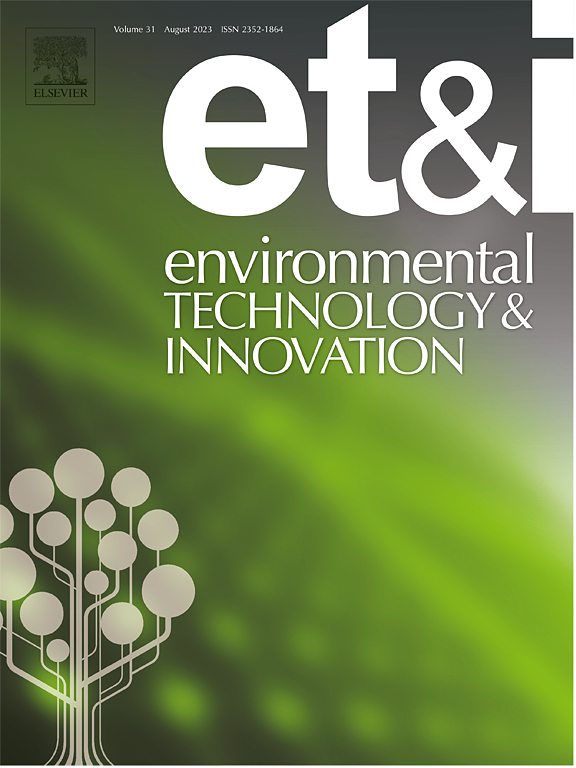Assessing subgroup differences and underlying causes of ozone-associated mortality burden in China using multi-source data
IF 6.7
2区 环境科学与生态学
Q1 BIOTECHNOLOGY & APPLIED MICROBIOLOGY
引用次数: 0
Abstract
Long-term ozone exposure is a significant public health concern. To mitigate its impact, it is crucial to identify diseases, populations, and regions that are particularly sensitive to ozone. In this study, we used high-quality data and updated relative risk estimates to investigate subgroup differences in mortality burden due to ozone exposure in China. In 2020, nationwide ozone-associated deaths totaled 276,800 (95 % CI: 106,700–451,900), representing 3.2 % of all deaths, with respiratory and cardiovascular diseases accounting for 16.8 % and 83.2 %, respectively. The per capita ozone-associated mortality in China was 20 per 100,000 person-years, with a significantly higher rate observed in elderly individuals aged ≥75 years (189 deaths per 100,000) compared to young individuals aged 30–44 years (1 death per 100,000). There were notable spatial patterns of ozone-associated deaths among the regions, indicating a critical response to ozone levels and population density. Interestingly, urban areas exhibited a 22.4 % lower mortality rate related to ozone compared to rural areas. This difference was attributed to the combined influence of ozone exposure (+19.9 %), population size (+17.7 %), age structure (−39.2 %), and baseline mortality (−20.8 %). By emphasizing subgroup differences and driving factors, these findings significantly enhance the understanding of the ozone-associated mortality burden, providing valuable insights for policymakers.
利用多源数据评估中国臭氧相关死亡负担的亚组差异和根本原因
长期接触臭氧是一个重大的公共健康问题。为了减轻其影响,识别对臭氧特别敏感的疾病、人群和地区至关重要。在这项研究中,我们利用高质量的数据和最新的相对风险估计值,调查了中国因暴露于臭氧而导致死亡的亚组差异。2020 年,全国与臭氧相关的死亡总人数为 27.68 万人(95 % CI:10.67 万-45.19 万),占总死亡人数的 3.2%,其中呼吸系统疾病和心血管疾病分别占 16.8%和 83.2%。中国与臭氧相关的人均死亡率为每 10 万人年 20 例,与 30-44 岁的年轻人(每 10 万人年 1 例)相比,年龄≥75 岁的老年人的死亡率明显更高(每 10 万人年 189 例)。各地区与臭氧相关的死亡人数存在明显的空间模式,这表明臭氧水平和人口密度对死亡人数有重要影响。有趣的是,城市地区与臭氧相关的死亡率比农村地区低 22.4%。这一差异是由于臭氧暴露(+19.9%)、人口规模(+17.7%)、年龄结构(-39.2%)和基线死亡率(-20.8%)的综合影响造成的。通过强调亚组差异和驱动因素,这些研究结果大大提高了人们对臭氧相关死亡负担的认识,为政策制定者提供了宝贵的见解。
本文章由计算机程序翻译,如有差异,请以英文原文为准。
求助全文
约1分钟内获得全文
求助全文
来源期刊

Environmental Technology & Innovation
Environmental Science-General Environmental Science
CiteScore
14.00
自引率
4.20%
发文量
435
审稿时长
74 days
期刊介绍:
Environmental Technology & Innovation adopts a challenge-oriented approach to solutions by integrating natural sciences to promote a sustainable future. The journal aims to foster the creation and development of innovative products, technologies, and ideas that enhance the environment, with impacts across soil, air, water, and food in rural and urban areas.
As a platform for disseminating scientific evidence for environmental protection and sustainable development, the journal emphasizes fundamental science, methodologies, tools, techniques, and policy considerations. It emphasizes the importance of science and technology in environmental benefits, including smarter, cleaner technologies for environmental protection, more efficient resource processing methods, and the evidence supporting their effectiveness.
 求助内容:
求助内容: 应助结果提醒方式:
应助结果提醒方式:


